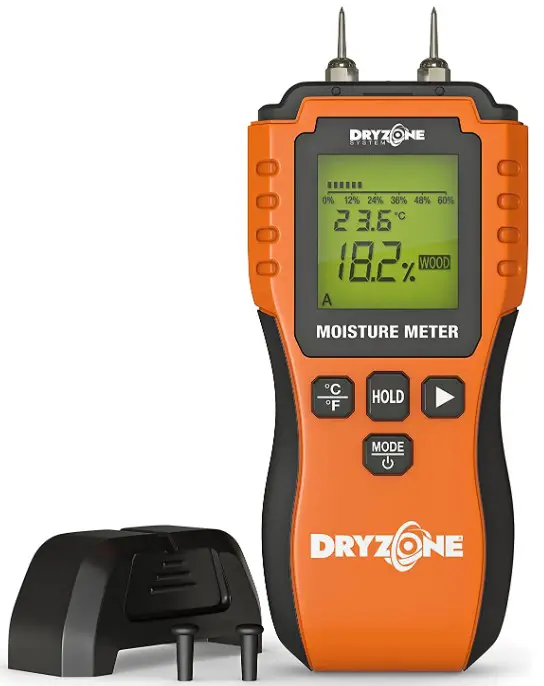Getting the perfect firewood to burn with your wood-burning stove at home can be a hassle, especially if you’re trying to find the firewood yourself. Not only do you need to know how to handle a chainsaw to split the wood into logs, you also need to know about the wood you’re cutting too.
There are certain types of firewood that are not suitable for your wood stove, and some that are absolutely perfect. Finding those perfect examples of firewood is the focus of today’s post.
Along the way, we’ll also be thinking about types of wood to avoid, how to identify wood, and provide you with some tips about identifying specific types of firewood you’ll want to burn at home on your wood-burning stove and what makes them easy/hard for your chainsaw.
Types Of Wood You Shouldn’t Burn On Your Wood-Burning Stove
Remember, firewood is the focus of today’s article, so only firewood should be used on your wood stove. You should never burn construction timber, painted wood, treated wood, pallet wood, or manufactured board products at home in your wood-burning stove because not all wood is safe to burn, and these examples aren’t, because they can release toxic fumes when burning that aren’t safe to inhale at home.
The only wood you should burn at home is firewood. You can purchase firewood from the store or from a local supplier, or you can find firewood yourself and use your chainsaw to chop it up – a popular method nowadays. If you choose to do the latter, then you’ll need to know some tips and tricks about identifying firewood, so you get the best for your home.
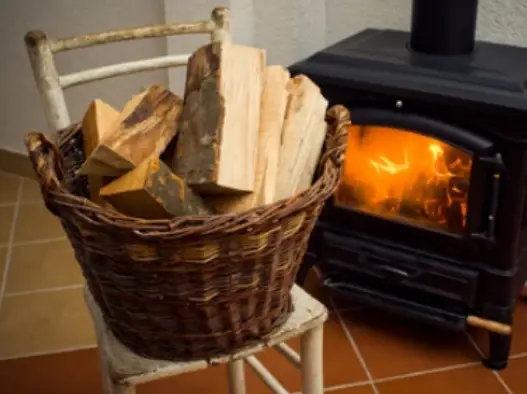
Tips For Finding The Perfect Wood To Burn
There are a few different types of firewood that are perfect for burning at home, but before we talk about the different types of great firewood, let’s discuss how to identify good firewood to burn.
Look For Well-Seasoned Wood
You may have heard the term well-seasoned wood before. Well-seasoned wood basically refers to wood that has a very low moisture content, so it’s much more suitable for burning at home.
Seasoned timber refers to wood that has generally been left to dry for a year or so until the moisture content reaches 20% or below. Most dry wood you buy from stores will be labelled as dry seasoned wood to indicate that it’s seasoned firewood that’s suitable for burning at home.
Seasoned wood increases the length of time your fire will burn too, and reduces the smoke that is produced compared to wet wood, whilst also helping to promote airflow to keep the flames hot and running cost low. Not to mention, drier wood is easier to cut using a chainsaw, since the moisture in the wood won’t compromise the integrity of the structure. So you should always choose seasoned wood where you can for wood burning.
But what if you aren’t buying your firewood from the store? How can you identify good firewood with a low enough moisture content?
Wood Moisture Metre
You can actually buy a wood moisture metre at home to help you determine the moisture content of different wood you find. Dry wood is always preferable to unseasoned wood or wet wood, so this should always be your priority.
However, just because you’ve found wet wood doesn’t mean you can’t still take it home and put it in your wood store to allow it to accelerate the drying process so you have enough timber stocked for the upcoming winter. A mixture of seasoned and unseasoned wood is great to have, because it means you can dry wet logs in your wood store whilst using other already dry wood in your home.
However, if you don’t have a moisture gauge at home, you can always identify firewood that’s suitable for burning with a few simple tests…

Identifying Firewood With Low Moisture Content Yourself
Use your nose, ears, and eyes to determine how suitable the wood is for burning:
- well-seasoned wood is darker in colour than unseasoned of the same species, which is often called green wood due to its lighter appearance and high moisture and sap content
- unseasoned wood has a sweet smell when you split it – a pleasant smell, but if it smells too sweet, you’ll need to dry it out for a few months before burning
- when you knock seasoned wood together, it should have a dry and hollow sound
Remember, unseasoned, wet wood has a poor quality combustion and will burn differently to high-quality firewood. The excess water contained in it makes the green colour visible in its bark and is a sure sign that it isn’t ready for burning, much less cutting up with your chainsaw. Keep this in mind when identifying firewood yourself.
Hardwood Trees VS Softwood Trees
The final tip for finding the best types of firewood is keeping the differences between hardwood species of trees and softwood species in mind when looking for other firewood.
Hardwood species grow slowly, resulting in dense wood that burns hotter and longer than softwood species. As a result, they also produce much less smoke and sparks, and are generally the types of wood you’ll want to use at home for safety. They also happen to be the easiest woods to cut up with a chainsaw, since the denser structure makes it easier to work with.
Softwood still has its uses as types of firewood, but they’re mostly reserved for outdoor bonfires and firepits where smoke isn’t such a problem – for wood to burn on your wood-burning stove at home, hardwood species are the best option. Softwood species are also not as easy to cut with a chainsaw. They’re called soft wood for a reason, and the motion of the cutter teeth against softwood can sometimes cause it to splinter, ruining the logs you’re splitting and making it more similar to kindling.
Preparing To Store Wood
Below we’ll talk about how to identify firewood based on a few different factors, but before we do, let’s talk about wood storage.
Earlier, we talked about how it’s important to have different types of wood at home at all times in terms of their moisture levels. Unseasoned, slightly seasoned, and ready to burn.
But to store it all, you need a suitable wood store to keep wet and drying wood in for a year or so until it’s ready to burn. All you need to do to speed up the drying time is split firewood into logs using your chainsaw, then place the split logs in the wood store and leave to dry. Later, you’ll be able to remove it and use your chainsaw again to split it into suitable logs for the fire.
This will ensure you always have a different type of wood ready to burn throughout the winter whilst other woods dry.
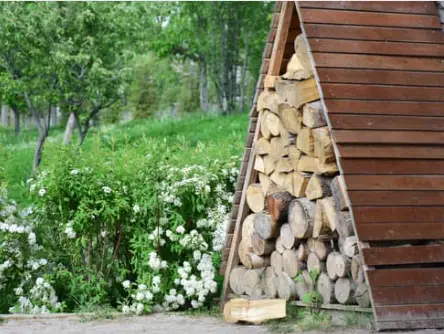
How To Identify Firewood
There are four ways to identify firewood:
- end grain
- tree bark
- colour
- leaves
End Grain
Oak and elm, for example, have very distinctive end grains, and many people in the forestry industry prefer this method to identify firewood because it’s highly accurate as different types of wood have different patterns and textures at the end grain.
Bark
Using the bark is also very helpful. Different types of wood have different bark types, and it’s relatively easy to identify them when you know what you’re looking for. For example, a hickory tree has flaky bark that’s very distinctive, but all wood types have their bark differences, too.
Colour
Colour is another way of identifying the type of wood you’re dealing with. For a cherry beech, for example, the colour is invaluable. Others may be more difficult to identify by colour alone, but it certainly helps to verify the type of wood you’re looking at if you have some other supporting information, like the grain or leaves.
Leaves
Speaking of leaves, this is the final way of identifying firewood. Maple leaves on a sugar maple, for example, are so easy to identify, so this should help in certain circumstances.
Different Types Of Firewood And Their Characteristics
Now that you know how to identify the type of wood you’re dealing with, let’s look at eleven of the most popular firewood types for burning at home, so you can identify it yourself.
Oak Firewood
To identify firewood from an oak tree, you really need to focus on the end grain, which has obvious rings to show the age of the oak tree. They also have lines running perpendicular to the rings, creating a unique end grain pattern.
If there are leaves nearby, then oak leaves are easy to identify too. They’re unique and have a five lobe design that we all instantly recognise.
Oak is great for firewood because it’s a hardwood that burns hot for long periods with very little smoke. It’s also one of the easiest woods to split using an at-home chainsaw because it doesn’t need a super powerful chainsaw to get the job done.
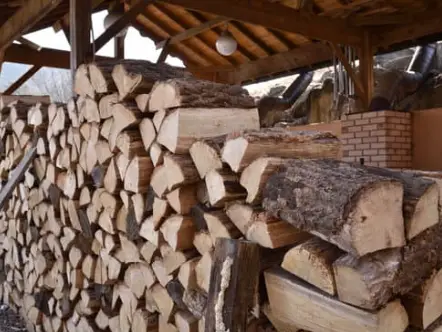
Pine Firewood
Pine wood is another great option, and it’s easy to identify again by its end grain, which is often covered in sap. Pines also don’t have leaves per se, but needles that are uniquely pine and smell wonderful and look distinctive. You won’t easily mistake a pine tree.
Pine is a great softwood option for outdoor burning. Pine creates shorter burning fires with a little more smoke than hardwood options, so whilst burning inside isn’t an option, outdoor fires are great with this wood. You can still use a chainsaw for splitting pine, just don’t go full throttle or else the log may fall apart easily.

Elm Firewood
Elm trees are easy to identify again because of their end grain. Most end grains have annual rings showing the age of the tree, but every other type of wood has annual rings that are uniform. Elm does not. The lines are wavy, making it very easy to identify.
Elm falls somewhere in between an oak and pine in terms of its hardness, and it’s actually technically a soft hardwood, but splitting this with a chainsaw should be simple enough. You certainly can burn it in your home on a wood stove, but keep your house well ventilated and ensure it’s completely dry to reduce smoke. This also works great as an outdoor firewood option.
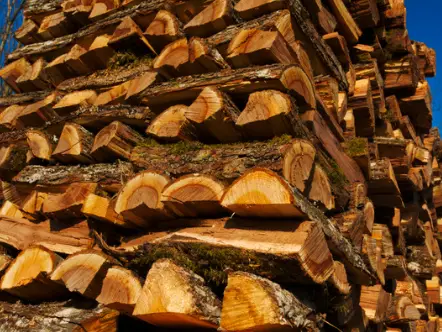
Cherry Wood
Cherry firewood is very easy to identify. Most of the wood we’ve talked about today has a light brown colour, but cherry wood is easy to identify because of its light red hue. If the wood has a red shade, then it’s likely cherry.
Cherry is great for indoor fires because it is a strong hardwood, releases very little smoke, virtually no sparks, and smells great. It doesn’t burn as hot as oak, but it can still easily heat a room. Just be prepared with your chainsaw for this one. It’ll take longer than oak to split too, because it’s a much denser wood.
Sycamore Wood
Sycamore trees have flaky bark that’s very easy to identify, as well as distinctive leaves which are basically the same as a maple’s, but massive. Identifying sycamore firewood is very easy indeed.
Although sycamore is a hardwood tree, it does have higher than normal moisture levels compared to other hardwoods, making it tricky to split with your chainsaw. Not impossible, but tricky, so be careful if you decide to go with this wood. It also means you’ll need to leave the sycamore to dry for a long time before burning, around 18 months or so.
Even when dry, a sycamore firewood fire will have moderate sparks and smoke, making it great for a wood-burning stove with a closed door, but not great for an open indoor fireplace. Outdoor fires are also common with dried sycamore, because they don’t burn for very long compared with other hard firewood.
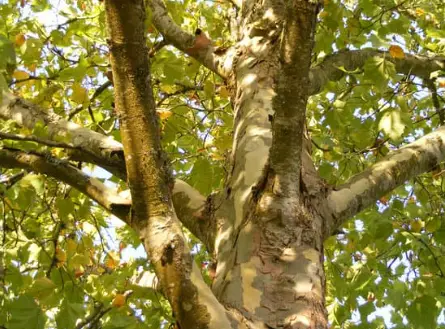
Mulberry Firewood
Mulberry trees are very easy to identify by colour, because they have a distinctive dark red centre, and a lighter, almost white outer colour. This is usually enough to identify this type of firewood.
Whilst mulberry trees are also considered hardwood (so are easy enough to split using your at-home chainsaw), they do produce a fair amount of smoke whilst burning. You should always use dry wood for your stove anyway, but this is especially important with mulberry firewood, which produces higher than average amounts of smoke. It gives off a delicious sweet scent when burning, though, so it might be a better choice outdoors if you want the benefit of the smell because it’s not suitable for open fireplaces indoors.
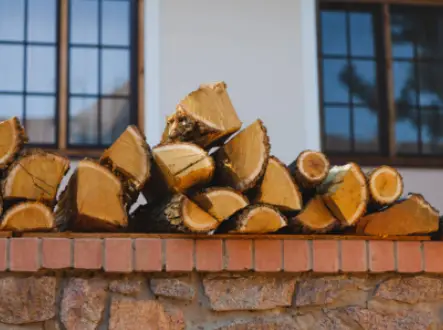
Maple Firewood
The only thing you’ll need for maple trees to identify them is the leaves. They’re the most recognisable in the world by far. If you’re simply identifying firewood after it’s been split into logs, though, then look out for the bark. It has a much tighter-fitting bark compared with other woods, which some describe as being like a skin.
Maple firewood is excellent because it burns for a very long time with a lot of heat, and smoke and sparks are kept to a minimum. It also smells great whilst burning, so this is a must-have for your wood stove! Whilst easy enough to cut with a chainsaw, maple isn’t the most stable wood in the world despite its hardiness, so just be aware that you might get a few duff logs from this wood – the rest will be perfect though!
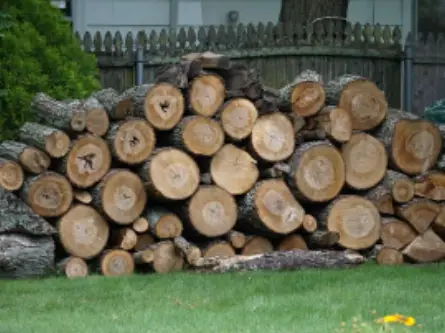
Ash Wood
Wood from an ash tree is easy to identify by the colour mostly, because it has a very light brown shade that’s almost white. If the colour alone isn’t enough, then ash trees are some of the only trees that have bark that form huge parallel ridges across it like deep trenches.
Ash makes for great firewood because it’s some of the easiest wood to split into logs using your chainsaw, it burns for a long time, and produces few sparks. It also has incredibly low moisture content right off the bat, so drying it is much quicker and it’s odourless when burning, which is great for indoor fires.

Hickory Firewood
Hickory trees also have flaky bark around it – that alone isn’t the defining feature though, because so do sycamore trees. Combine this with distinctive leaves with 7-9 leaflets on each large leaf, though, and you can easily identify hickory trees.
Hickory firewood is certainly for outdoor use, mostly. There’s a reason you get so much food that is ‘hickory smoked’ and it’s because this type of wood, even when fully dry, produces a lot of smoke. It smells great and tastes wonderful, too, but it’s not something you want in your home. Used for barbecues and outdoor fires, though, hickory wood is a great choice.
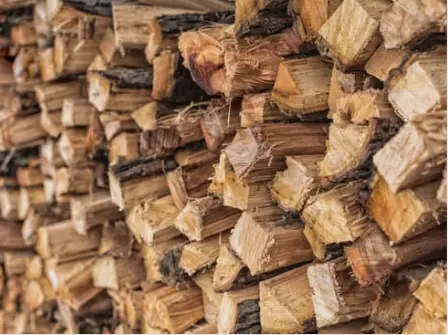
Pear Wood
Firewood from pear trees usually comes from the Bradford pear tree, which has a light pink/reddish colour to the inner wood, and distinctive tear shaped leaves, making it quite an easy wood to identify.
Pear wood is great for burning because although it grows fast, it burns clean, and makes for a great option at home. The wood produced is heavy and dense, making it burn for a long time too, but it’s difficult to split because of the strange, crooked shape of the Bradford pear tree’s branches making it difficult to find an effective place to put your chainsaw to split it. Because it’s so fast growing, a lot of landowners see these types of pear trees (which don’t produce fruit) as a pest, so you can usually find it for sale if you know where to look.
Birch Firewood
Our final firewood option comes from the birch tree. The simplest way of identifying birch firewood is the colour, but be wary, since there are many types of birch trees, from black to yellow to silver. Usually it’s the colour of the bark that gives the trees these names, though, so identifying the wood by colour alone is pretty standard for birch trees.
As a firewood, yellow and black birch varieties are best because they burn hot for a long period and give off a pleasant smell. Yellow birch varieties of wood will need to be dried for around two years, though, due to moisture content, whereas black birch typically only needs around a year.

The Perfect Logs For Splitting With Your Chainsaw
Now you know the perfect wood for your wood stove and/or outdoor fire, it’s important to know what makes a log good for splitting with your chainsaw. The following tips apply to all types of firewood.
To make your job easier with your chainsaw, you need a log that is:
- straight
- thick
- sturdy
- heavy enough to deal with the chainsaw motion
- dry enough to cut without risk of it splitting
Find wood like this, and it’ll be much easier to cut it into logs with your chainsaw.
DIY VS Store-Bought
To finish, let’s just look at the DIY vs store-bought debate around firewood. Some will argue that it’s easier to buy from a store and so you don’t need to know how to identify the different types of firewood. But they’re only half right.
It’s easier to buy from a store or local supplier, but knowing how to identify the wood is still key. How else will you know if you’re getting what you pay for?
Of course, if you are going to find the firewood yourself and cut it with your chainsaw, then it’s even more important that you know what firewood to look for to make the cutting easier.
However you decide to get your firewood, though, knowing the best ways to identify them and when it’s suitable for burning is vital.
Final Thoughts
Remember to stay away from painted or treated wood, stick to the eleven types of firewood that are perfect for burning at home (either indoors or out), look out for seasoned wood for burning (but remember to keep wetter wood drying in your wood store too), and keep the tips and tricks for identifying the best types of firewood in mind and the best logs for cutting with your chainsaw, and you’ll be able to pick out suitable firewood for burning before you know it!


